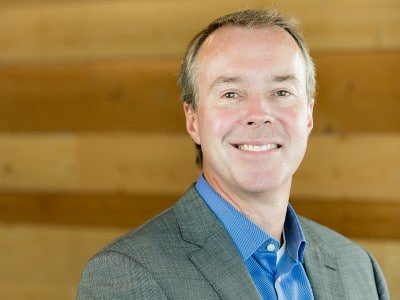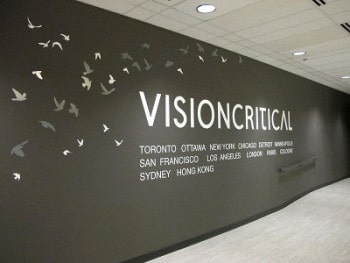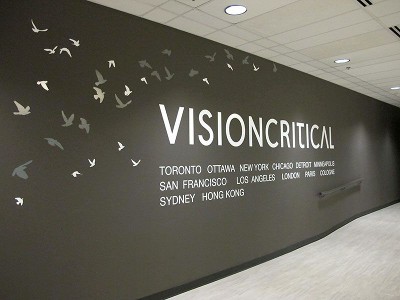

Vancouver’s Vision Critical is constantly in the mix during recent discussions around Canada’s next wave of tech IPOs, and yet unlike the other companies in that group that are more public-facing, such as Hootsuite or Shopify or Vidyard, there’s a slight sense of mystery about the company.
But for analysts who understand the centrality of customer intelligence and insight communities for how technology will affect social life, and how those activities differ from straight-up marketing, Vision Critical is as cutting edge as it gets.
It’s as if Vision Critical is surveying today’s marketing landscape from a rear view mirror, while they push forward into a future in which “marketing” as we know it has already been transformed into an ongoing dynamic between business and customer, fueled by always-on communication.
The evolution of Vision Critical into something more than a “market research” company can be traced to the fact that company founder Andrew Reid grew up watching the mechanics of how a decidedly 20th-century market research firm works, as perfected by his father Angus Reid.
Founding Vision Critical in 2000, Andrew brought that paradigm of “market research”, pens and pencils and telephone surveys, firmly into the 21st century, developing methods of customer engagement and intelligence gathering that have come to define what everyone else has taken up as talking points today.
In 2012, Scott Miller was appointed from COO to CEO, and this past November the Canadian Innovation Exchange gave him its Innovator of the Year award.
Vision Critical’s customer intelligence platform is now used by hundreds of companies and organizations across verticals ranging from municipal politics to transportation systems to healthcare companies to sports organizations to major corporations.
As notions like “the empowered consumer”, “co-creation” and “customer intelligence” are bandied about at other companies, a quick overview of Vision Critical’s work demonstrates that it has owned these concepts from the beginning, partly because it’s baked in to the company’s DNA.
Cantech Letter spoke to Vision Critical CEO Scott Miller by phone.
What’s the difference between what Vision Critical does and traditional “market research”?
The big shift in the transition from market research to what we now call “customer intelligence” is that we believe very strongly in the science that is market research, but that it’s being applied very differently since, really, the advent of this customer revolution. The minute, a decade ago, when any given customer became empowered to reach any other customer on the planet, all of a sudden things changed. Every customer is exchanging information and opinions about brands that matter to them. And that really changed the landscape of how brands needed to engage with those customers. People now expect to matter. Which means it’s not enough to simply survey them in a clinical fashion and analyze the results. Because, like I said, they’re engaged with Twitter, they’re engaged with Facebook, they expect to matter. People care how many people are following them on Twitter and listening to their points of view. And people that have grown up in this ecosystem, call them the Millennials if you will, that’s all they know. They’ve only known a world in which they engage with brands that matter to them, and if those brands can make it clear that they also matter, then those people will stay engaged. And so really what we view as having transitioned or transformed is this idea that people do matter. And the science behind market intelligence, or customer intelligence, is figuring out how to get them engaged, how to keep them engaged, and you do that by making sure that they know they matter to the organizations or businesses that are trying to gather that information. So it’s a continuous conversation, as opposed to a single transactional event, and it must be reciprocal. So your community members, your customers, must be getting some sort of value out of engaging with you. Either they get a sense of empowerment because they’re in an advisory group and they know the impact they’re having on your business, or they might have access to privileged content because they’re a special group of customers, or whatever it may be. Or they just might find it a very entertaining form of engagement. Any of those things drive that engagement and keep them engaged with the brand. And this is what we call “the customer revolution”, which is that customers have decided, “Look, we’re powerful now. We’re in charge.” So, as a result, businesses that figure out how to harness that and embrace those customers are going to win. Businesses that continue to treat their customers in a transactional manner are going to, over time, lose or erode the relationships that they have with those customers. So that’s how it’s evolved. And the science now is making sure you can engage these people and still collect information and deliver some sort of value back to those community members and then act upon the information that you’re collecting in order to make business decisions that keep those customers close to you, whether through products or services.
While Big Data and predictive analytics will continue to get more and more accurate, we don’t see a time in which people will no longer want to or need to actually engage with real people.
What have been your challenges over the last five years or so, convincing companies that there’s actually a return on investment in engaging their customers? Essentially, it sounds as though the concept of ROI for the customer, a reciprocal ROI, is just as important as the company’s ROI.
It’s interesting. I would say it might have been a struggle five years ago. But now, if you want to engage with your customers, if you want to talk to them, they’re so busy. They’ve got their smartphones, there are so many options for them. If you want them to engage with you as a brand, they must be able to get something out of it in order to keep them engaged continuously, coming back time and again to provide insider intelligence back to you, or what we call “collective wisdom”. So I would say we’ve learned that the subject matter has to be relevant to them, the way that you engage them has to be entertaining and meaningful. And ultimately, they have to feel like they matter to you as a brand. And that is most frequently reinforced by letting them know what you’ve learned and what you’ve done with that information, so that they really are clear that they are in an advisory capacity, and not just a piece of data for you. As we all know, the amount of money being invested in Big Data is enormous. And yet, ultimately, in order to make that final decision, we’re finding that more and more of our customers at some point need to talk to people. They need to engage with actual real humans and test ideas, understand attitudes and opinions, even in the context of the intelligence that they are extracting from their predictive analytics and their Big Data models. While Big Data and predictive analytics will continue to get more and more accurate, we don’t see a time in which people will no longer want to or need to actually engage with real people. That’s the big shift with the customer revolution. If I come up with the right content, and do it creatively and in the right way, I can have a major impact on a brand or on a group of people who are following me. And that creates an expectation that I actually do matter. And that’s what brands are, to your point, maybe struggling with a little bit. And it does go against many of the old or traditional market research views, about potentially influencing your target sample by providing them too much intelligence or information. We would actually say that that is the norm now, rather than the exception.
 That sounds like a delicate formula to get right. Your senior vice-president of marketing, Nick Stein, just spoke at SXSW about getting the mix between “aspirational” and “prescriptive” approaches to content marketing correct. I guess that’s the balance between letting the consumer drive a process vs. guiding them. Is that a formula you’ve figured out, or is it different in every case?
That sounds like a delicate formula to get right. Your senior vice-president of marketing, Nick Stein, just spoke at SXSW about getting the mix between “aspirational” and “prescriptive” approaches to content marketing correct. I guess that’s the balance between letting the consumer drive a process vs. guiding them. Is that a formula you’ve figured out, or is it different in every case?
Within that prescription is just the question of content and the empowered customer’s quest for more information. The more information they have, the more empowered they are. So there’s an opportunity to provide information that is objective and reliable. You can’t really fool or mislead people, nor should you. It can be the same kind of reliable content that helps build a stronger relationship between you and your customer. It is a combination of science and art, without a doubt. We are able to build more and more formulaic solutions, but it does vary definitely by sector, and in many cases it does vary specifically by brand and even by the community that you’re engaging with within the brand. So if you just think about the different types of constituencies or customer groups that any brand has, like age stratification, how different your twentysomething customers are from your fiftysomething customers, and the type of content that they might find relevant, the types of activities they might find engaging, the more you know about that customer group, the more you can build a formula and hit that balance. That’s what we believe is so important in building a community, the collective wisdom that you accumulate by communicating with them and learning from them over time. It’s not a single transactional event. It is a constant conversation, and a constant trial of ideas and gathering reactions. The formula starts as art, let’s say, and it evolves toward being more and more data driven and more scientific, as you build that collective wisdom with your community members.
In December, Vision Critical published a paper called “What Social Media Can’t Tell You About Your Customers”. Obviously, social media has become a vital, new, important thing for business to understand, but can we think of it as the tip of an iceberg with regards to customer behaviour? Can it even be a little misleading?
We would regard it as accurate for a small group of your customer base. That was a study conducted with several of our customers, who participated with us in the analysis. For me, the biggest “a-ha” was the percent of people who are on social media, but who are not providing active content. As a result, as a brand you may have 90% of your customers active in social media, but only 29% are actually providing any kind of content. So while you’re harvesting and monitoring what you may think is your customer sentiment, it’s actually a very small, somewhat homogenous group of your overall customer base. So if I were building my intelligence solution, I would be looking for themes coming out of social media, and then I would be testing those themes with my community, because I know that community extremely well. I know the various types of customers that are in that community, how much they shop with me, spend with me, their attitudes toward me. I know that I’ve got people that are favourable or not favourable toward my brand or things that I’ve done. And that’s what I would engage to understand whether those various themes in social media are relevant or not.
It’s not a single transactional event. It is a constant conversation, and a constant trial of ideas and gathering reactions. The formula starts as art, let’s say, and it evolves toward being more and more data driven and more scientific.
What do you think that business culture can learn from the sharing economy and start-up culture and those sort of phenomena?
My favourite lesson coming out of that is, the more you give, the more you get. Some people would say that started with concepts of open source, years before the sharing economy even started to blossom. But I think that’s something we see in the community model, as well, in that the more the community members are participating, typically the more information or knowledge or rewards they get back from the participation. I would also say that we try and instruct our customers that the more information they’re willing to provide back about what they’re learning, and what maybe the community members can learn as well, and what they’re doing with that information, the more engagement and the more content or value they’ll get back from their community members. And without going into too much detail, because it’s so early, I think you and your readers can play out the scenarios about where that all heads. I think we’re in just the very, very early stages of that particular model. And I think we will get to a point, definitely in our world, in which the greatest customer engagement activities, if you will, are delivering as much, if not more, value to the community members, the customers who are participating, than they’re actually doing to the people who are fielding the surveys. It’s going to be very important to those sponsors, too. But again, in order to continuously keep your customers engaged, you need to find intrinsic ways of incentivizing them and motivating them to stay close to your brand and activities or engagements that you want them to do. Like I said, we’re just in the very early stages of the insights world, or the intelligence community, really figuring out how to crack that. But, yeah, we’re engaged with various customers and starting experimental pilots with some pretty exciting concepts in that area.
It’ll be the companies that figure out how to leverage and collaborate with the empowered customer that are going to have the greatest opportunity for success. Even in the most mundane B2B spaces, you can’t hold it back. The customer is empowered, and this open sharing of information and engagement with brands is going to continue to fuel industry.
In media, which is more customer-facing, we’ve seen mainstream broadcasting and newspapers disrupted by new players like Buzzfeed or Vice, who appear to have come up through cultivating a very close relationship to their audience. But how does this play out in other, less customer-facing verticals like healthcare or consumer packaged goods, let’s say?
I think healthcare is becoming very customer-facing. The industry has a lot of restrictions around, obviously, data privacy and security, which we all take very, very seriously. But if you think out a few years, it’s hard to imagine that sufferers of various illnesses or what have you won’t be aligning and trying to build their own communities, where they can, in a more quantitative or scientific way, get feedback from each other on what types of treatments work, what types of experiences have been good and bad and things of that nature. And I think it’ll behoove the hospital networks and the insurance companies to think through how they can actually leverage that desire for more information, for more intelligence, to actually build stronger relationships with their patients or with their customers. So healthcare is definitely one that I think will see a lot of evolution. And even in CPG, concepts like co-creation and crowd-sourcing of ideas, I think we’ve only begun to see the very early stages of that. You mentioned before the collaborative economy, and the convergence of the collaborative economy and co-creation and crowd-funding might actually take the CPG space, too. It’s pretty exciting to think about. But I would say that what underpins it all, from our standpoint, is that as that evolves in any direction, it’s going to be the empowered customer that takes it there, and it’ll be the companies that figure out how to leverage and collaborate with the empowered customer that are going to have the greatest opportunity for success. Even in the most mundane B2B spaces, you can’t hold it back. The customer is empowered, and this open sharing of information and engagement with brands is going to continue to fuel industry.
Vision Critical has expanded over the last few years into a lot of new markets. You’ve opened offices in the U.K. and Australia and New York, and have gone on a hiring spree recently. How are you going to be focusing your efforts over the next two to three years? What’s the next frontier?
The next frontier for us is that our offer, which is this insight community and customer intelligence platform, is maturing. And as it matures, the demands for the offer and/or the use cases are becoming more and more targeted, specialized and sophisticated. Our focus right now is to continue to accommodate the growing and increasing needs of our customer base, to continue to enable them to bring in that empowered customer, to take the greatest advantage and keep that empowered customer closely engaged with their brand. So that really is priority number one. It does mean that we focus and scale at the same time. Focus on the use cases, but then scale our platform to meet the specialized use cases of more and more of our customers. That really is, more than any singular priority, where we’re focused. To be very honest, there’s a lot of speculation, we get a lot of questions about what’s next from a capitalization standpoint. We are so focused, we’re not even really commenting on the various scenarios that are out there. We’re focused on scaling our platform and our solution to meet the increasing demands of our customers, because ultimately the key thing is that they continue to get more and more value out of the platform and the communities that they’re building. Our greatest guarantee of our own success is the success of our customers, and really, that is front and centre right now.
Anyone looking at Vision Critical from the outside will get the impression that it’s very cutting edge, that it’s very disruptive and all that. But it feels like, in some sense, what you’re doing is dragging people’s attention back to the centrality of, for lack of a better word, storytelling. And you often mention the importance of treating consumers like human beings first, more so than as data sets. Do I have that wrong?
No, you’re right. Over the last 30 or 40 years, the reality is that mass production and mass communication, mass distribution have probably made the individual customer less and less influential, less and less powerful. But with the customer revolution that began, arguably, with social technology about a decade ago, all of a sudden the individual regained a lot of that influence, if you will. So, to your point, it’s a very old-fashioned value, that maybe dissipated over time and has been reborn. And we think it’s fantastic. What’s more appropriate than the democratization of decision-making and influence in brands and businesses? We’re very excited about that transformation.
Leave a Reply
You must be logged in to post a comment.






 Share
Share Tweet
Tweet Share
Share




Comment